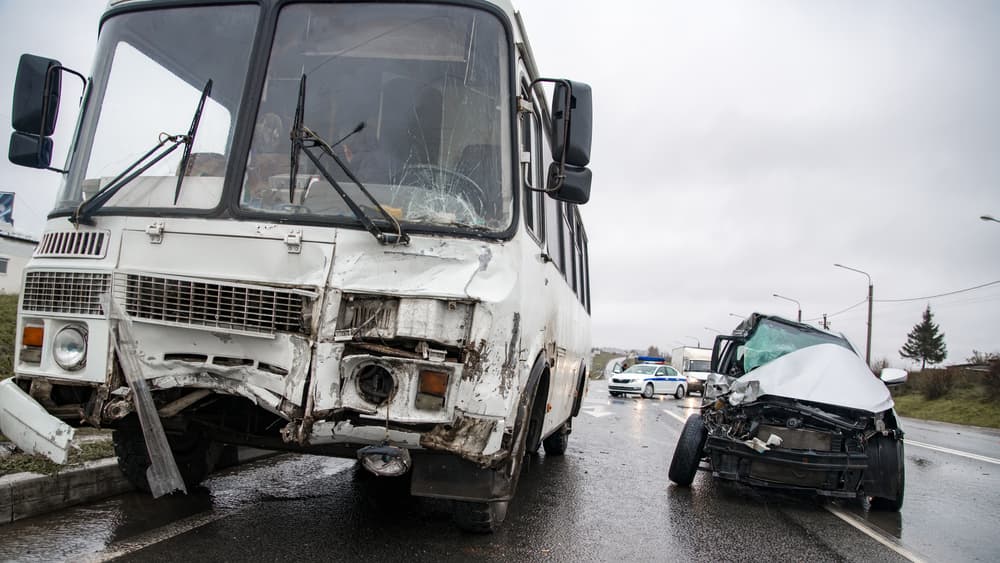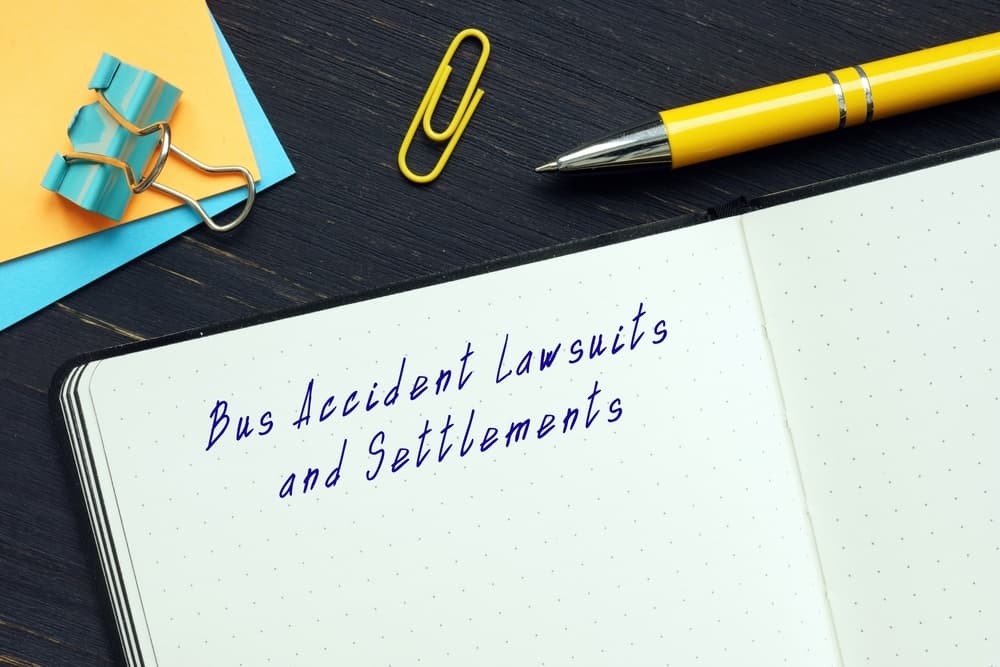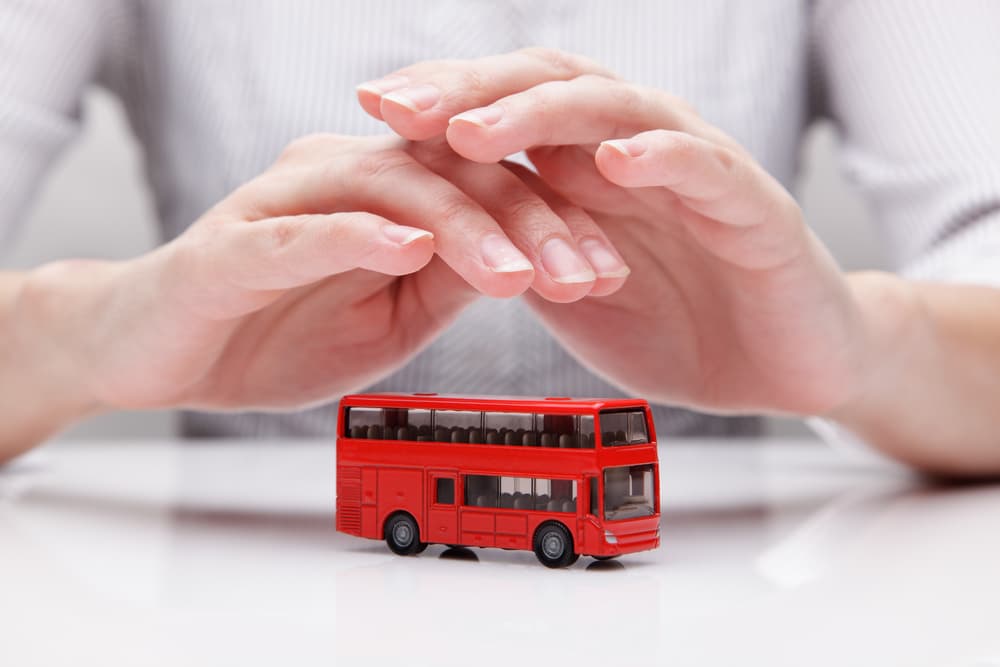When bus drivers, bus companies, or third-party drivers commit negligent acts on the road, the chances of serious accidents and injuries increase dramatically. If you recently suffered injuries as a passenger on a charter bus, school bus, tour bus, or municipal bus, you may be entitled to recover various types of monetary compensation.
In addition to getting the medical treatment you need, you need to talk with a knowledgeable bus accident lawyer in Edmonton right away. Your lawyer can go over your legal rights and options with you, file a claim on your behalf, or pursue litigation in the court system for a favourable resolution.
Types of Bus Accidents

Bus accidents can happen for many reasons, often due to negligence by others. Negligence occurs when someone fails to act with reasonable care, leading to harm or injury. Here are some of the most common types of bus accidents that result from others’ negligence:
- Driver Error – Bus drivers may cause accidents by speeding, running red lights, or making unsafe lane changes. Distractions like texting or talking on the phone can also lead to serious accidents.
- Driver Fatigue – Bus drivers may become fatigued from long hours on the road, leading to slower reaction times and increased risk of accidents.
- Poor Bus Maintenance – Neglected bus maintenance can result in mechanical failures, such as brake malfunctions or tire blowouts, causing accidents.
- Improper Training – Inadequate training for bus drivers can lead to improper handling of the vehicle, increasing the likelihood of accidents.
- Overloading – Overloading a bus with passengers or cargo can affect its stability and braking ability, bringing about a collision.
- Other Drivers – Bus accidents can also result from the negligence of other roadway drivers, such as reckless driving or driving under the influence of drugs or alcohol.
- Pedestrian Accidents – Negligent bus drivers may fail to yield to pedestrians or fail to see them while making turns or backing up, resulting in accidents and sometimes fatalities.
- Defective Equipment – Defective parts or equipment on the bus, such as faulty brakes or steering mechanisms, may cause the bus to malfunction while on the road, causing a collision.
- Inadequate Supervision – Lack of proper supervision by bus companies or government agencies can lead to lax safety standards and an increased risk of accidents.
- Intoxication – Bus drivers who are under the influence of drugs or alcohol pose a serious risk to passengers and other road users.
- Failure to Follow Applicable Regulations – Bus companies and drivers may neglect to follow safety regulations that local, provincial, or national authorities establish, further increasing the likelihood of accidents.
If you sustained injuries in one of these types of bus accidents, a local bus accident lawyer can investigate your accident circumstances and prepare a claim for you.
How to Successfully Prove a Claim or Lawsuit Involving a Bus Accident

Proving the legal elements of a bus accident claim or lawsuit requires gathering evidence and demonstrating key elements:
- Duty of Care – The first element to prove is that the bus driver or bus company owed a legal duty of care to the passengers. This duty involves operating the bus safely and following all applicable traffic laws and regulations.
- Breach of Duty – The next step is to show that the duty of care was breached, meaning the bus driver or company failed to uphold their responsibility. This may include engaging in reckless driving, speeding, distracted driving, or other negligent behaviors.
- Causation – An injured bus passenger must also demonstrate that the breach of duty directly caused the accident and resulting injuries. This requires linking the negligent actions of the bus driver or bus company to the harm which the bus passenger suffered.
- Damages – In order to pursue financial compensation, it’s essential to prove that actual damages occurred as a direct result of the bus accident. Damages can include loss of earning capacity, lost income, pain and suffering, and other losses.
To prove these legal elements effectively, several pieces of evidence can be crucial:
- Eyewitness Testimony – Statements from bus passengers, pedestrians, or other drivers who witnessed the accident can provide valuable insight into what happened and who was at fault.
- Police Reports – Official police reports documenting the details of the accident, including statements from the involved parties and any citations issued, can serve as strong evidence in a bus accident claim.
- Surveillance Footage – Video footage from nearby cameras or onboard surveillance systems can also provide visual evidence of the accident and help to establish liability for the bus accident.
- Bus Maintenance Records – Maintenance records showing whether the bus was properly inspected and maintained can indicate whether mechanical failure likely played a role in the accident.
- Expert Analysis – Expert testimony from accident reconstruction specialists, medical professionals, or safety experts can help explain complex issues and provide support for the injured bus passenger’s case.
- Medical Records – Medical records documenting the injuries that bus passengers sustained as a result of the accident are essential for proving damages and calculating compensation.
By carefully collecting and presenting this evidence, victims can build a strong case for their bus accident claim or lawsuit, increasing their chances of obtaining fair compensation for their losses.
Successfully Settling or Litigating a Bus Accident Case
When pursuing monetary compensation for a bus accident resulting from negligence, there are two main paths: settling the claim or litigating it in court. Here’s how each process works:
Settling the Claim
- Negotiation – After the accident, the injured parties (plaintiffs) or their legal representatives typically negotiate with the bus company’s (or municipality’s) insurance company (or legal team) to reach a settlement agreement.
- Demand Letter – The negotiation process often begins with the plaintiff’s lawyer sending a demand letter to the at-fault party or their insurer, outlining the damages suffered and the amount of compensation sought.
- Counteroffer – The at-fault party or their insurer may respond with a counteroffer, either accepting the proposed settlement amount, rejecting it, or offering a different amount (i.e. a counteroffer).
- Settlement Agreement – If both parties agree on a settlement amount, they sign a settlement agreement, releasing the at-fault party from further liability in exchange for the agreed-upon compensation.
- Release of Claims – Upon reaching a settlement, the plaintiff typically signs a release of claims, waiving their right to pursue further legal action related to the bus accident.
Litigating the Claim
- Filing a Lawsuit – If settlement negotiations fail or if the plaintiff believes the offered amount is inadequate, they may choose to file a lawsuit against the bus company, bus driver, or other at-fault party.
- Discovery – The discovery phase involves both parties exchanging information and evidence related to the case, including witness statements, accident reports, medical records, and expert opinions.
- Pretrial Motions – Prior to trial, both parties may file pretrial motions, such as motions to dismiss certain claims or evidence, which the court will consider before proceeding.
- Trial – If the case goes to trial, both sides present their arguments, evidence, and witnesses before a judge and jury. The jury then decides whether the at-fault party is liable for the accident and, if so, the amount of damages to be awarded in the case.
- Appeals – Either party may choose to appeal the verdict if they believe legal errors were made during the trial – or, in some cases, if they disagree with the outcome. Appeals can prolong the litigation process.
Whether settling or litigating a bus accident claim, it’s important for the plaintiff to have legal representation to handle the legal process and pursue fair compensation for their injuries and losses.
Injuries that Bus Passengers Suffer in an Accident
When a bus collision occurs due to a bus driver or bus company’s negligence, passengers can suffer a range of physical and mental injuries. Here are some of the most common types of injuries they may experience:
- Whiplash – Whiplash is a common injury in bus accidents, where the sudden collision causes the passenger’s head to jerk forward and backward rapidly, straining the neck muscles and ligaments.
- Broken Bones – The force of a bus collision can result in various broken bones, such as fractures in the pelvis, ribs, arms, wrists, feet, legs, or ankles, causing severe pain and mobility restrictions.
- Head Injuries – Bus passengers may also suffer head injuries in an accident, ranging from minor concussions to traumatic brain injuries (TBIs), which can have long-term consequences on cognitive function and overall quality of life.
- Back Injuries – The force of a collision can cause back injuries, including herniated discs, spinal fractures, or soft tissue damage, leading to chronic back pain and restricted mobility.
- Internal Injuries – Bus accidents can also cause internal injuries, such as organ damage or internal bleeding, which may not be immediately apparent but can be life-threatening if left untreated.
- Psychological Trauma – The psychological effect of a bus accident can be significant, leading to depression, anxiety, post-traumatic stress disorder (PTSD), or other mental health disorders that require counselling and other types of mental health treatment.
- Cuts and Lacerations – Flying debris or broken glass from the bus collision can cause cuts and lacerations to passengers, resulting in pain, scarring, and the risk of serious infection.
- Burns – If a bus catches fire or there is an explosion during the collision, passengers may suffer burns of varying degrees, requiring immediate medical attention, long-term rehabilitation, and sometimes surgeries.
- Whiplash–Associated Disorder (WAD) – In addition to neck pain, WAD can cause headaches, dizziness, and cognitive difficulties, affecting daily activities and quality of life.
- Emotional Distress – Witnessing or experiencing a traumatic event like a bus accident can lead to emotional distress, including fear, guilt, or anger, which may require counselling or therapy to address.
- Loss of Life – In the most severe cases, bus accidents can result in fatalities, leaving families devastated by the loss of loved ones and facing financial hardships.
Recovering Monetary Damages for Injuries in a Bus Crash

After experiencing injuries in a bus accident, victims may seek various forms of monetary compensation to cover their losses and damages. Here are some common types of compensation they can pursue:
- Lost Income – Bus accident victims may receive compensation for income lost due to their injuries, including income from missed work days, reduced work hours, or inability to return to work temporarily or permanently.
- Pain and Suffering – This type of compensation is intended to cover the physical pain and emotional distress experienced as a result of the bus accident and subsequent injuries. It accounts for both the immediate pain and any long-term suffering that the bus passenger has to endure.
- Disability or Disfigurement – Bus passengers who suffer permanent disabilities or disfigurement (such as scarring) as a result of the bus accident may receive compensation for the effects these injuries have on their quality of life, earning potential, and self-esteem.
- Loss of Consortium – Spouses or family members of the injured party may also be entitled to receive compensation for the loss of companionship, support, and services resulting from the victim’s injuries.
- Punitive Damages – In cases of extreme negligence or misconduct by the bus company or driver, punitive damages may be available as a form of punishment and deterrence. These damages hold the responsible party additionally accountable to hopefully prevent similar incidents from occurring in the future.
Recovering these forms of compensation typically involves filing a claim with the bus company’s or municipality’s insurance provider or pursuing a lawsuit against the negligent party. It’s important for bus passengers to carefully document their injuries, keep records of medical treatment and expenses, and consult with a personal injury lawyer to navigate the legal process and maximize their chances of receiving fair compensation.
By seeking compensation for their injuries and losses, bus accident victims can alleviate their financial burdens, access necessary medical care and support, and begin the process of rebuilding their lives after a traumatic bus accident.
Speak with an Experienced Bus Accident Lawyer in Your Area Right Away
If you suffered injuries in a recent bus accident, it is essential that you retain skilled legal counsel in your case as soon as possible. A knowledgeable Edmonton personal injury lawyer can swiftly investigate your accident, prepare a personal injury claim for filing, negotiate on your behalf, or pursue litigation in the court system.
